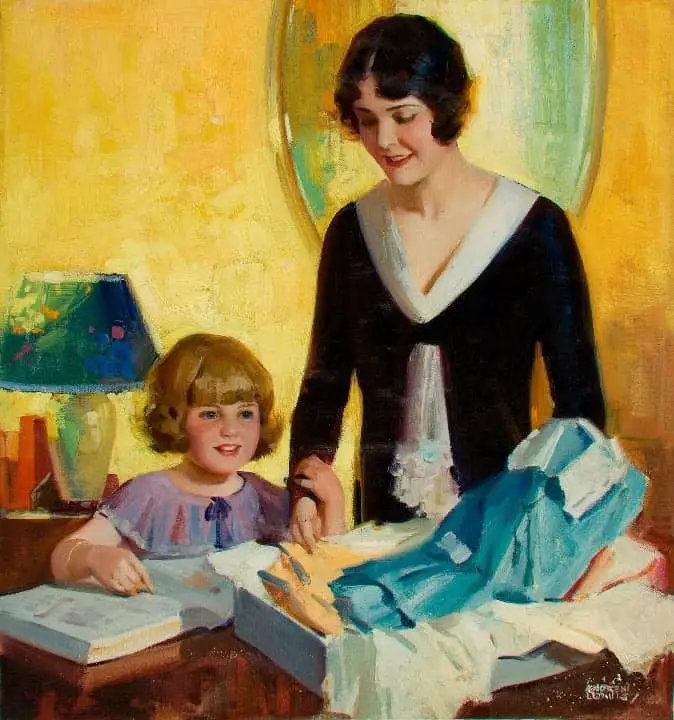“New Dresses” (1912) is nowhere near as accomplished as Katherine Mansfield’s later short stories as it lacks focus and appears contrived. “New Dresses” is a different sort of story altogether from the Prelude trilogy, and we need a different yardstick. That said, The Carsfield family is said to be the prototype of the Burnells who we meet later in Prelude, At the Bay and The Doll’s House.
Read “New Dresses” at The Katherine Mansfield Society website.
I’m interested in why “New Dresses” is considered ‘contrived’. What makes one story feel contrived and another natural, given that both are made from scratch, technically making one as contrived as the other?
STORY STRUCTURE OF “NEW DRESSES”
“New Dresses” is the story of a family and the family’s toxic dynamics rather than the story of an individual. In these cases, the narration will be a fairly distant third person, ducking from one character’s head to another.
This is a story about parenting. Especially by today’s parenting standards, the Carfield adults are terrible.
“New Dresses” is valuable as an historical document of parenting practices common in early 1900s New Zealand. My own grandparents — and to a lesser extent my parents — were certainly brought up with some of the practices seen in “New Dresses”:
- The belief that corporal punishment is an effective way of stopping unwanted behaviours. Also: That delayed corporal punishment has an even stronger effect, because the child must spend time dreading it, which is supposed to give them extra time to ‘mull it over’.
- The belief that if corporal punishment is dished out alongside exchanges of love, the child will not be damaged. This view of parenting is still disturbingly common, but if adults hurt their children while requiring the child to tell them they love them, or when telling the child that they are loved, the adult is preparing that child for a
- Lack of understanding about neurodiversity, and in this case the idea that stuttering is an affectation — that when children are ‘different’ they’re doing it because they’re attention seekers.
- Overt favouritism between one’s own children, predicated on an old-fashioned view of genetics — that some children are just born better than others, and that your treatment of them has nothing to do with anything.
NARRATION
The sympathetic adult is the doctor. The doctor is also the viewpoint character, and viewpoint characters tend to automatically align with the audience. The doctor is the only reasonable adult in the story. We are encouraged to side with his point of view and with his actions. It is especially easy to side with him as a modern reader, since the culture of parenting has changed considerably.
Also by today’s standards, it’s odd and borderline creepy for a man to make off with a little girl’s dress, even if his intentions with it are honourable.
The doctor is the character who has the revelation at the end and, for my purposes, that makes him ‘the main character’ as well as ‘the erstwhile viewpoint character’.
“New Dresses” is divided into two quite distinct parts:
- The conversation between Mrs Anne Carsfield and the grandmother as Mrs Carsfield makes the dresses on the sewing machine. This scene exists to show the family’s dynamic, though ‘showing’ is via dialogue.
- The scenes including the children and the doctor, whose lively personalities make for a much more engaging read.
It’s possibly a mistake to have started where Mansfield did. She needed some way of conveying to the reader:
- The favouritism. Helen is insecure within the family structure.
- The mother’s irritating emphasis on image and dresses
- The grandmother’s way of deferring. Although Helen’s grandmother understands, the elderly woman is powerless to act.
But in general, writers need to trust readers to pick up subtleties, and I believe it was possible to convey those ideas in a shorter scene, or to combine them into a subsequent one. I believe this is one major reason why “New Dresses” feels contrived to some readers.

SHORTCOMING
The shortcoming of the family: The parents can’t see their children equally.
The shortcoming of the grandmother: The first scene shows us she’s powerless within the family structure, but the doctor’s anagnorisis will show us there’s a little more to it than that.
There’s plenty to be said about gender roles in this story, too. If these characters weren’t victims of a strict delineation of gender, they’d all be a lot better off:
- Although women of this class aren’t even allowed to work for money, and although unpaid the labour of shopping and sewing falls upon them, Mrs Carsfield is roundly criticised for performing her wifely role. And as part of that criticism, her husband talks about ‘his’ money, as if it doesn’t belong rightly to all of them. The reader doesn’t know if Mrs Carsfield has flagrantly spent money they don’t have — she thinks to herself that they have more than enough and that her husband is treating her like a child. I’m inclined to go with that, because of Henry Carsfield’s attitude towards ownership of the finances, and also because he seems to think making trousers out of old ironing material is prudent. He doesn’t seem to realise, as his wife does, that there would be a social cost to such frugality.
- Whereas the girls are required to be still, ostensibly to protect their expensive dresses, boys are expected to behave in a rough, and probably very annoying, manner. The Boy (unnamed, since his gender is the main point as far as Mansfield is concerned) bangs a spoon for a solid five minutes. Instead of a reprimand, the father says, “Go it, old man. Tell Mother boys like to kick up a row.”
DESIRE
Mrs Carsfield wants to dress her children in pretty clothes for church, but of course it’s not about the clothes, per se. Her deeper desire, so we can deduce, is for her family to look good in the eyes of the community.
She could not help thrilling, they looked so very superior.
(Superior to who? To their former, undressed selves, or to certain other social classes in their community?)
OPPONENT
For an image conscious mother such as Anne Carsfield, a daughter like Helen is a curse. Helen is hardly boisterous by her little brother’s standards, but she is not a naturally clean and tidy girl, which embarrasses her mother. Mother and daughter are the main opponents here, though Henry Carsfield and the grandmother could nip this in the bud if they had a mind to.
PLAN
It feels good to write a story and then send a capable character in to save an underdog. Here we have a doctor who steps in to save Helen. Mansfield gives the reader enough information to know what he’s done — he’s taken the dress, and we can guess he’s going to have it fixed.
Meanwhile, Helen’s father plans to punish his daughter with corporal punishment.
The Grandmother isn’t happy about this, but we learn later that she deals with these parenting decisions by buying presents for her grandchildren after they have been roundly whipped. She has consoled Helen with this. (I can’t think of many worse ways in which to ruin a child.)
BIG STRUGGLE
An underdog character is about to get a whipping for something that isn’t wholly her fault. (Expensive material shouldn’t rip so easily, especially not when the child is doing a regular childhood thing, such as sitting on a swing.)
The natural Battle scene in a story like this is the whipping scene itself, but Mansfield knows this isn’t the interesting thing. Writers don’t have to write the most obvious scene.
That said, we can’t skip any part of compulsory story parts either, and the Battle stage is not optional.
So what’s the Battle stage in this particular story?
The discussion in the girls’ bedroom in which Helen denies doing anything with the dress, and in which Henry refuses to believe her, forms the first part of the Battle. The second is the visit from the doctor to the grandmother, which leads right up to the doctor’s anagnorisis.
ANAGNORISIS
When the doctor hears the grandmother’s response, and laments that she can’t give her granddaughter the new doll unless she ‘earns it’ by enduring the whipping, he knows the problems in this family run much deeper. He had mistaken the grandmother for someone who understands the toxicity running in the family, assuming her simply powerless to intervene. But now he realises she doesn’t understand at all, in which case she is useless to Helen, and to the doctor’s own wishes to act.
The reader may realise something at this point, too. By trying to help, the doctor may have made things worse. Helen has sworn to her father that she left the dress in her bedroom, but the doctor has taken it, and the story is that Helen took it to school. It now appears that Helen has lied as well as torn her dress.
NEW SITUATION
I fully expect that Helen will receive her whipping — possibly a double dose — and the grandmother will give her the doll.
Helen will learn that whenever good things happen in life, she doesn’t fully deserve them until enduring terrible experiences first. Her natal family is preparing Helen for a subservient role in an abusive marriage.
What do you make of the ending? Do you think the doctor took the dresses, or do you think his story about Lena, and Helen taking it to school saying she’d grown out of it, is true? Do you think Helen will escape a sound smacking if the grandmother tells Helen’s parents she found the dress under her dolman? (What’s a dolman? It describes any number of loose robes, based on the Turkish model.) I’m pretty sure a mother who makes dresses will notice if one of her creations has been sewn up.
Perhaps part of the problem with this ending — and its contrivance — is that we’re not sure if Mansfield herself had all of this straight in her head.

